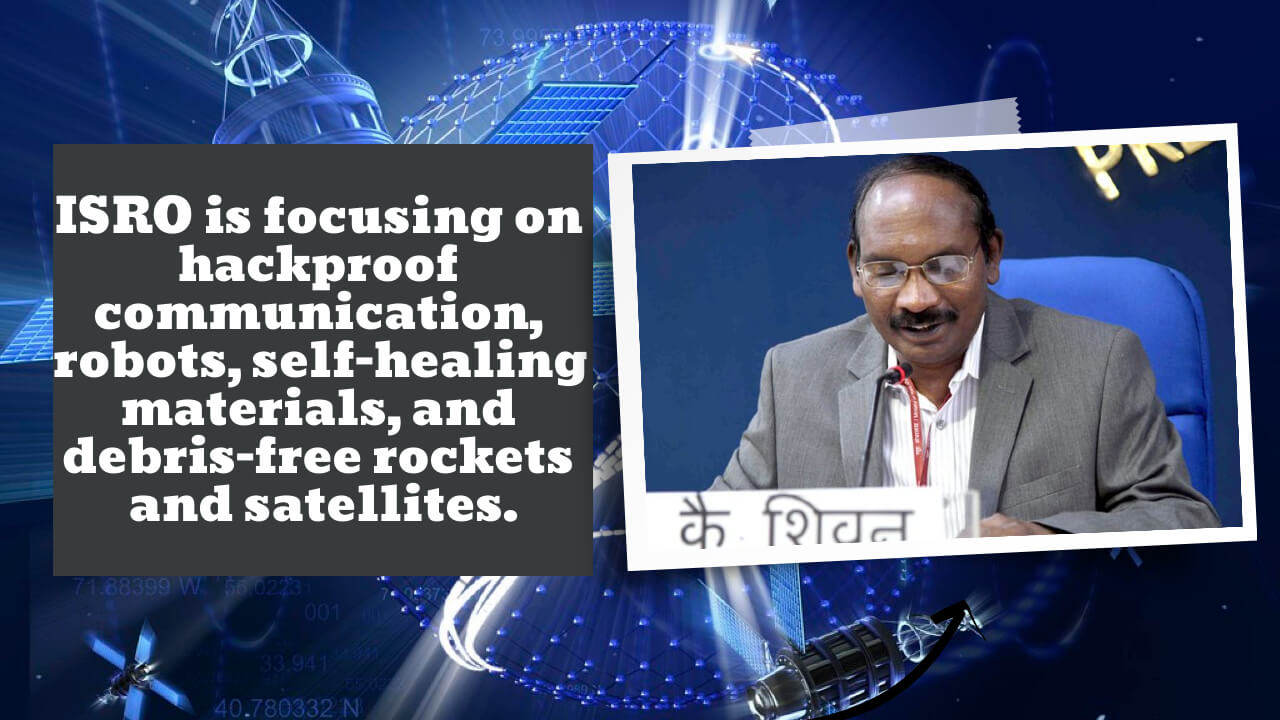ISRO is developing more than 50 futuristic and creative technologies to meet India’s technical demands. A few examples of these cutting-edge technologies are satellite-based quantum communication, robotic arms, space debris mitigation, and interplanetary rovers. Based on input from ISRO’s scientists and engineers, the organization has developed a “Vision 2030.” Humanoid robots, in-situ propellant production for interplanetary exploration, the sample of planetary rocks, intelligent spacecraft, robotic arms in space, spider rovers, AI-enabled ships, and a composite lattice construction make up the bulk of the project’s list of features.
Key Highlight:
- Indian Space Research Organization (ISRO) is developing more than 50 cutting-edge technologies to meet India’s growing demand for high-tech goods and services in the years ahead.
- These include quantum communications, space debris mitigation, robotic arms and interplanetary rovers, among other technologies.
- Humanoid robots, in-situ propellant generation for interplan planetary exploration, planet sampling, an artificial intelligence space vehicle, a spider rover, and a composite lattice structure are all part of the project.
- ISRO will also deploy artificial intelligence, machine learning, and big data analysis in the future, according to the project’S ‘Vision 2030’ proposal.
- The project is based on input from ISRO’’ scientists and engineers.
Indian Space Research Organization (ISRO) is developing more than 50 cutting-edge technologies to meet India’s growing demand for high-tech goods and services in the years ahead.
These include quantum communications, space debris mitigation, robotic arms and interplanetary rovers, among other technologies. During the inaugural session of the Directorate of Technology Development and Innovation (DTDI) conclave, top ISRO officials included these technologies.
According to Dr K. Sivan, ISRO’s Chairman, DTDI was established as a specialized Directorate at ISRO headquarters to plant the seeds of future and disruptive technology for the space sector.
A SWOT analysis of the technology’s potential applications was also taken into consideration, he said. Dr. Sivan, the secretary of the department of space, said that ISRO, Indian industry, and academics would bring these innovations to fruition.
During the past three years, ISRO has launched 46 technical endeavors, including quantum communication, space-debris mitigation technologies, such as self-eating rockets, self-vanishing satellites, and robotic arms to gather space debris,” Dr Sivan stated. Quantum communication, satellite-based quantum communication, and quantum cryptography could all be used to guarantee data security in secure connections, he explained.
There is an increasing need to minimize space trash, satellite overcrowding, and wasted rocket stages, which are all serious concerns.
To maximize the use of reusable rockets, enable in-space refueling and satellite maintenance, reduce space trash and produce materials that don’t represent a long-term threat to other space assets, a global effort is currently taking place.. ISRO’s plan for self-eating rockets, self-destructing satellites, and robotic arms must be viewed in this context.
Physical features of nature at the subatomic level are described by quantum mechanics, which is a physics theory. Traditional physics describes many features of the natural world on a small scale (macroscopic).
Traditionally, confidential data and the digital keys required to decrypt it are delivered through cable or other ways. 0s and 1s are represented by a continuous stream of electrical or optical pulses (bits). The problem is that this can be hacked without the knowledge of both the sender and receiver.
Quantum bits (quantum bits) transport photons of light, which are both 0 and 1 at the same time. A hacker would have to measure these qubits to be able to eavesdrop on it, which would alarm both the sender and receiver. A quantum state can’t be measured without upsetting it, according to this premise. Both parties will know if the qubits are disrupted, and they might choose to abandon the transaction.
When discussing disruptive technologies, Quantum radars, low-temperature lithium-ion cells that can power sub-systems in sub-zero temperatures, and space-based solar power were all cited by R. Umamaheswaran, scientific secretary, ISRO.
According to him, scientists and engineers at the Indian Space Research Organization (ISRO) came up with a ‘Vision 2030’ based on their thoughts.
Humanoid robots, in-situ propellant generation for interplanetary exploration, planet rock sampling, an intelligent space vehicle, a robotic arm in space, a spider rover, an artificial intelligence (AI)-enabled spaceship, and a composite lattice structure is all part of the proposal.
On the current status of these technologies, he stated that many of them were in the early stages of feasibility studies, while others had already been developed in the lab.
As part of its efforts to better comprehend Earth’s resources, ISRO will also deploy artificial intelligence, machine learning, and big data analysis.
On-board anomaly detection in spacecraft, Spatio-temporal weather prediction, groundwater level prediction, production of land cover maps, AI-driven quality inspection and AI agriculture are some of the areas where we are focusing our efforts,” Dr Umamaheshwaran said.
ISRO hopes to bring together technology developers from all around the country with potential customers through programs like DTDI connect and DTDI extend to enable customized goods ready to be introduced.
As a result of these technology products and services, the country will benefit significantly from the resulting spinoffs.
5-day #ISRO Technology Conclave-2021 took off today. It will showcase futuristic technologies and is organised by Directorate of Technology Development & Innovation (DTDI) which is an important link for Industry, Innovators and Academia. pic.twitter.com/OrGFdvWrVm
— Dr Jitendra Singh (@DrJitendraSingh) November 22, 2021




